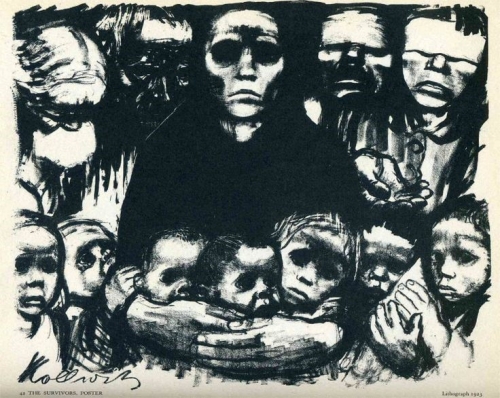Never again war: the life and work of Käthe Kollwitz

Jenny Farrell introduces the life and work of Käthe Kollwitz, one of Germany’s greatest artists and sculptors, who produced unforgettable images of the violence, injustice and crimes against humanity perpetuated by the capitalist econmic and political system.
Käthe Kollwitz's artistic work reflects the events of the first half of the 20th century - yet she continues to stand tall among anti-war artists and champions of the dispossessed of our time.
Kollwitz broke completely with bourgeois aesthetics and made the subjugated, humiliated working class her sole artistic subject. In her work, she expresses eloquently the force, the resistance and the humanity of this class. Very often, she focuses on individuals, or small groups, who exemplify the fate of thousands, balancing their misery with dignity and human kindness.

City Shelter, 1926
This year marks the 150th year since Käthe Schmidt’s birth in Kaliningrad, daughter of a bricklayer who recognised his daughter’s artistic talent early on. Barred from studying art as a woman in her hometown, she moved to Berlin and Munich to pursue her education. There, she met radical artists of her time and married the socialist Karl Kollwitz, a medical doctor who lived among and treated the poor of Berlin. Together they dwelled in the then impoverished working-class (and now gentrified) Prenzlauerberg district for most of their lives. Here, she gave birth to two sons and created her substantial oeuvre.
Kollwitz’s breakthrough work, which defined her artistic signature, was the cycle The Weavers, inspired by witnessing in 1894 the premier of Gerhart Hauptmann’s drama of the same name, about the 1844 uprising of Silesian weavers. Over and above connecting present misery with that of the past, Kollwitz focuses on resistance against social injustice. Reflecting on this early experience, Kollwitz noted in her autobiography, that the play, research and work on the weavers’ rising was a key event in her artistic development. The cycle consists of three lithographs (Poverty, Death, and Conspiracy) and three etchings (March of the Weavers, Riot, and The End). The Weavers became Kollwitz's most well-known work.
Stirred by her working class surroundings and involvement, Kollwitz’s second cycle The Peasant War, going back to the German uprising of the 1520s, also centres on the rebellion of the exploited and suppressed against social injustice. Peasant War is worked in a variety of techniques: etchings, aquatint, and soft ground and are counted among Kollwitz’s greatest achievements: Plowing, Raped, Sharpening the Scythe, Arming in the Vault, Outbreak, After the Battle and The Prisoners. After the Battle depicts a mother’s night-time search through the dead, looking for her son.
Loss and grieving became a central theme in Kollwitz’s work after the death of her son Peter in the early days of WWI. From now on, mothers protecting their children, fighting for their survival, grieving their death, are an ever-present motif in Kollwitz’s work. She conveys a profound sense of unspeakable tragedy and of human responsibility to fight against death-spawning militarism and war. The people, the victims, are also those where humanity is found and the only source of resistance.

The survivors, 1923
In 1919, Käthe Kollwitz began work on the woodcut cycle War, responding to the tragedies of World War I. Seven images reflect her unspeakable pain. Stark, large-format woodcuts feature the anguish of war: among them, a mother sacrifices her infant (The Sacrifice), in The Volunteers Kollwitz depicts her son Peter beside Death, who leads a group of young men to war in a frenzied procession. Once again eliminating specific references to time or place, Kollwitz created a universal condemnation of such slaughter.

From the cycle War, The Volunteers, 1921/22
The assassination in January 1919 by right-wing militias of Karl Liebknecht, sole German parliamentarian to vote against further war loans in the summer of 1914, occasioned her famous woodcut In Memoriam Karl Liebknecht. It is a moving tribute to this communist leader, mourned by the people he represented, who pay their final respects in a shocked, yet gentle fashion.

In Memoriam Karl Liebknecht, 1920
In 1924, Kollwitz created her three most famous posters: Germany's Children Starving, Bread, and Never Again War. After the Nazi rise to power, in the mid nineteen thirties, Kollwitz completed her last great cycle of eight lithographs, Death.

Never again War, 1924
More heartbreak was wrought on her in 1942, when her grandson Peter fell victim to Hitler’s war. This death came after that of her husband Karl, who had died of illness in 1940.

Seed corn must not be ground, 1942
Käthe Kollwitz died on 22 April 1945, just a few days before WWII ended. She has left us with unforgettable images of the horrific events and epic struggles of her lifetime. Kollwitz’s images remain profound indictments of the capitalist economic and political system, a system that perpetuates such terrible violence, social injustices and crimes against humanity.

Jenny Farrell
Jenny Farrell is a lecturer, writer and an Associate Editor of Culture Matters.
Latest from Jenny Farrell
- Poetry for the Many, an anthology by Jeremy Corbyn and Len McCluskey
- A hopeful vision of human renewal: the theatre of Seán O'Casey
- Art that's rooted in the upheavals of his time: Caspar David Friedrich, 1774-1840
- A Drive to Change the World: James Baldwin, Black Author, Socialist and Activist
- A woman's perspective on the invisible front: A review of 'The Shadow in the Shadow'
